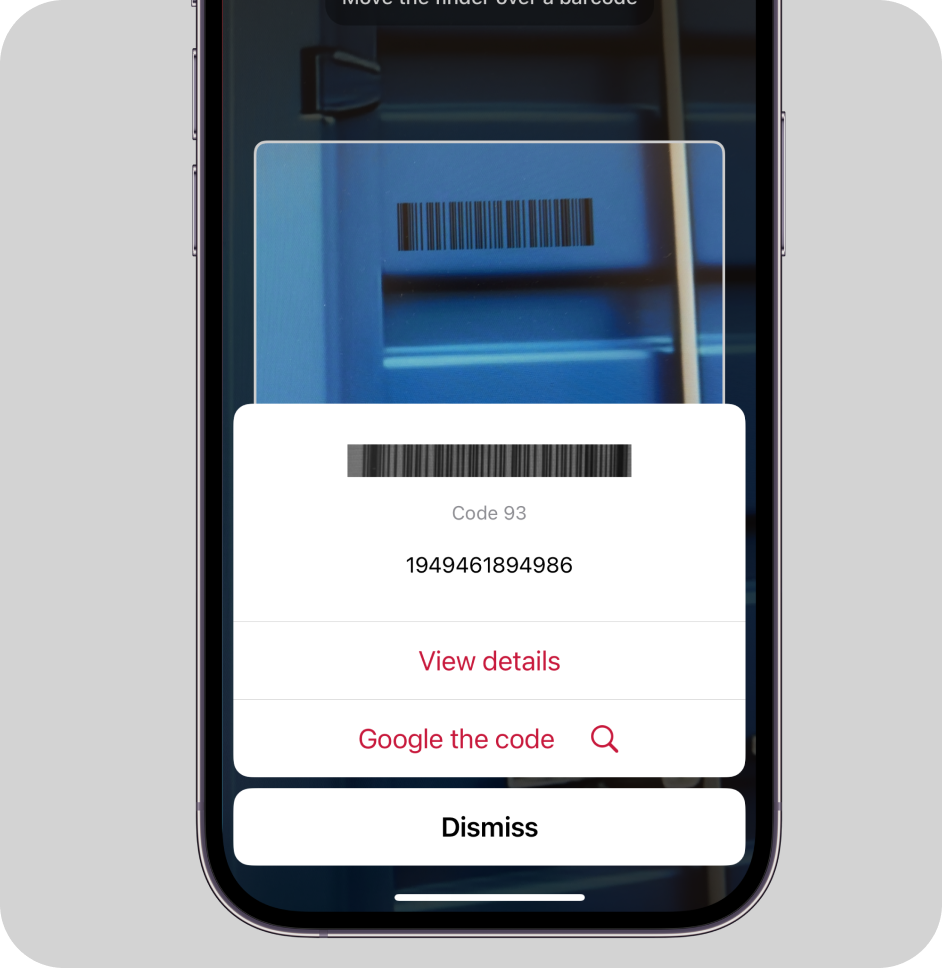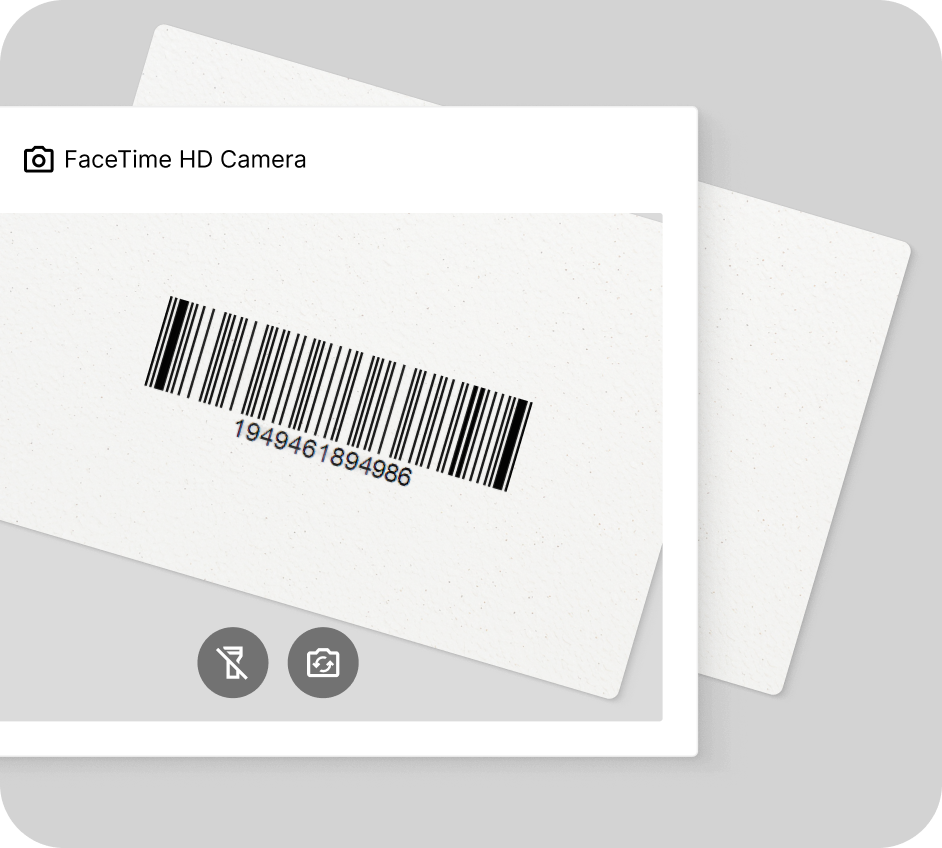Code 93 Barcode Scanner
Add Code 93 scanning to your mobile application or website
Trusted by
300+
global
industry leaders
Turn smartphones into fast & reliable Code 93 scanners
The Scanbot Code 93 Barcode Scanner SDK delivers exceptional performance even under challenging conditions – such as code damage or when scanning small codes commonly found in industrial applications like warehousing and manufacturing. With a scanning speed of under 0.04 seconds, your users get instant reads for seamless workflows.
Key benefits include:
- Offline scanning: The Scanbot SDK works 100% on-device, ensuring both uninterrupted performance and data security.
- Enterprise-grade support: Get dedicated chat support via Slack, Teams or email for any issue. Includes free assistance during the integration phase.
- Flat pricing model: Cost stays the same no matter how much your user base or scanning volume grows.


How this scanning tool works
Our free online Code 93 barcode reader scans codes directly through your camera or on imported images. This barcode scanner works in any browser, no app download or signup needed. Enjoy real-time camera view scanning or decode barcodes on pictures in seconds – just point your camera at the Code 93 barcode or import an image file to instantly access the encoded data.
This tool is powered by the Scanbot Barcode Scanner SDK!
(We don’t store any images or data you import. Everything stays on your device.)
Understanding Code 93 barcodes
What is a Code 93 barcode?
Code 93 is a one-dimensional (1D) barcode symbology standardized in ANSI/AIM-BC5-2000. Developed in 1982, it was among the first barcodes to support alphanumeric data, including letters, numbers, and some special characters. Today, Code 93 is widely used as a logistics and packing barcode to identify packages.
Each barcode includes start and stop characters (an asterisk *) that help barcode scanners identify the code’s boundaries. Additionally, Code 93 barcodes contain two check digit characters for enhanced error detection.
Most barcode scanners easily scan Code 93 barcodes and, as the text interpretation is placed below the barcode, support manual verification.
Structure and components
Code 93 encodes characters using patterns of wide and narrow bars and spaces. Each data character in a Code 93 symbol consists of nine modules arranged into three bars and three spaces, hence the name. Each bar or space can be one to four modules wide.
The default implementation or standard mode of Code 93 can encode 47 characters, including digits (0–9), uppercase letters (A–Z), and the special characters -, $, %, <space>, ., /, and +. An asterisk (*) is used as the start/stop character. Four additional characters enable an extended or Full ASCII mode, which can encode all 128 ASCII characters.
Another defining feature is its two mandatory modulo-47 checksum characters, known as the “C” and “K” checks. These are calculated from the data and help ensure the barcode is read accurately by scanners.
Overall, Code 93 barcodes consist of the following key components:
- Quiet zones: Blank areas on both sides of the barcode that aid proper detection and readability.
- Start character: An asterisk (*) that indicates the beginning of the barcode.
- Data characters: The main content section where information is encoded.
- Two check digits: Enable error detection.
- Stop character: An asterisk (*) that indicates the end of the barcode.
- Termination bar: A single bar that separates the stop character from the quiet zone.
Encoding and error detection
Code 93 can encode the entire 128-character ASCII set by using combinations of two characters, allowing it to represent both standard and extended characters efficiently.
The symbology’s pair of modulo-47 check characters (C and K) enables error detection to ensure data integrity. They are calculated and encoded using a table of numeric values for every character.
Each character in the barcode is assigned a numeric value based on a predefined table.
Here’s how the checksum is calculated and encoded:
- Numeric values are assigned to each character in the data portion of the barcode.
- The C checksum is calculated first, using a weighted sum of the data characters’ values.
- This sum is divided by 47, resulting in a remainder.
- The character corresponding to the remainder value is appended to the end of the barcode.
- Then the K checksum is calculated using the same method, but including the C character, and appended.
Applications of Code 93 barcodes
Across industries, Code 93 is frequently used in internal inventory system tools, especially because of its compact size and higher density of data compared to many other 1D barcodes.
Manufacturing and automotive
Code 93 is common in the automotive industry and in factory automation for tracking components, parts, and work-in-progress items. It is used for assembly line management and quality control, especially where space is limited, as for small parts.
Healthcare
While less common than Code 128 or Data Matrix, Code 93’s compact size is useful for smaller labels for medical equipment, lab samples, and hospital inventory.
Logistics and postal
Code 93 barcodes see use in logistics applications for tracking packages, pallets, and shipping containers. Carriers use it to encode tracking numbers, destination codes, and routing information, but also for inventory management.
Retail
Code 93 is also used in retail operations, specifically retail inventory management, warehouse operations, and order fulfillment. The main use cases are labelling stock, organizing bin locations, and managing product movements.
Advantages of Code 93 barcodes
- Size: Code 93 offers greater data density than Code 39 by using 9 modules per character and a more compact encoding scheme. This allows for shorter barcodes with the same information.
- Error detection: Code 93’s checksum characters enable basic error detection, though no error correction.
- Versatility: Code 93 can hold alphanumeric data and has no length limit, making it useful for a variety of applications.
- Omnidirectional scanning: The asymmetric start/stop character enables decoding from any angle.
Why choose the Scanbot SDK for Code 93 scanning?
The Scanbot Barcode Scanner SDK is specifically designed to handle the challenges of decoding Code 93 barcodes in real-world scenarios. We can empower any enterprise or consumer mobile or desktop app with advanced barcode scanning capabilities with minimal integration effort.
What sets us apart:
- Exceptional performance: Reliably decodes even damaged, low-contrast or distorted barcodes.
- High-speed scanning: Read Code 93 barcodes in as little as 0.04 seconds.
- Cross-platform compatibility: Easily integrate with Android, iOS, cross-platform, web, Windows, and Linux platforms.
- Customizable UI: Customize the ready-to-use components to match your app or website design.
- Privacy-first: Operates offline for complete data security.
Whether your use case involves Code 93 barcodes, QR codes, or any other barcode, the Scanbot SDK delivers the accuracy, speed, and reliability you need to succeed.
Related Barcode Types:
- Data Matrix Scanner
- QR Code Scanner
- PDF417 Scanner
- Aztec Code Scanner
- Code 128 Scanner
- EAN Scanner
- UPC Scanner
- Micro QR Code Scanner
- GS1 DataBar Scanner
- GS1 DataMatrix Scanner
- GS1-128 Scanner
- MaxiCode Scanner
- ITF Scanner
- Codabar Scanner
- Intelligent Mail Barcode Scanner
- rMQR Code Scanner
- Royal Mail Scanner
- Micro PDF417 Scanner
Frequently Asked Questions
Is Code 93 still used today?
Yes, Code 93 is still used today, mainly in manufacturing, retail, the automotive industry, healthcare, and logistics.
What’s the difference between Code 93 and Code 39?
Code 93 is an enhanced version of Code 39, designed to be more compact and reliable. It allows for higher data density and includes two checksum digits for better error detection.
What’s the maximum length for a Code 93 barcode?
The Code 93 is a variable-length symbology and has no hard limit on the number of alphanumeric characters it can encode. It can accommodate both short and long data strings, depending on the use case. For reliable scanning, though, the optimal length is 43 characters or less.
Are there any security concerns with Code 93?
Code 93 offers better accuracy than other codes, such as Code 39, but its two checksum characters (C & K) only detect basic errors. They offer no protection against tampering or spoofing.
Moreover, data is stored in plain text, without encryption, making it easy to read, copy, or forge with a basic scanner. This poses risks in systems requiring trust or authentication.
Cloud-based scan software creates another attack surface. A fully offline Code 93 Barcode scanner introduces no such data security issues and ensures uninterrupted performance.